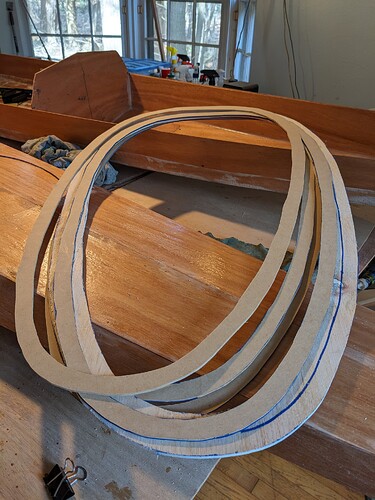Might be a light at the end of the tunnel after all. Making the coaming base out of six 1/8th inch thick ovals of particle board x 3/4" wide, and for the coaming lip, two 5mm thick ovals of plywood, x 1 1/2" wide. Tedious but should be worth it.
Why are you using MDF for the coaming instead of marine plywood? Is that standard procedure?
Particle board is not as strong or water-resistant as BS 1088 Okoume and it’s much heavier. It’s more prone to warping than marine plywood. I would not use it if that was my boat. And MDF is even worse in this application.
Laszlo
Not sure what standard procedure is, but the kit prescribes using a single 1/8" thick strip of plywood, 7/8" wide, wrapped around the cockpit deck, said strip standing vertically upon its 1/8th inch thick side. Not only did the strip crack when I attempted installation of it, but even had it not cracked, its mere size/thickness did not inspire confidence as to durability and strength. Getting in and out of the boat, I figured there’ll be times I’ll be leaning full body weight on the coaming base and coaming lip. The thing’s got to be toughly constructed. So the next choice seemed to be to place several strips of coaming, laid down flat, each 3/4" wide, and 1/8" thick, with each strip soaked in epoxy, placed one flatly on top of the other. That would I expect provide a firm, non-breakable base. Granted MDF isn’t as rugged as plywood, for sure, but wood ain’t cheap these days, and each piece would require a 2’ x 4’ board. So I opted for the less costly MDF board, and like I said, each piece is getting soaked in epoxy during installation. It’s one, 1/8th inch thick piece, on top of another. So there’s going to be very little stress on these pieces, even with my full body weight on them. The coaming lip itself will be two pieces of 5mm plywood, each soaked in epoxy as well. If the thing fails, I’ll let the forum know, so as no one else tries it! ![]()
MDF is not going to absorb a significant amount of epoxy and it will eventually absorb water and disintegrate. You will regret using it having spent so much time building your boat. As for the strength of using a 1/8th thick piece of plywood, the riser, after being tacked into place, receives a fillet of epoxy/cabosil and then a layer or two of bias cut fiberglass on both sides that both strengthen the riser and bound it fully to the deck.
in case you haven’t seen it, here’s Nick Schade’s YT video on making the S&G Night Heron coaming.
As you can see, the 1/8" plywood strip is the standard procedure. Nick reinforces it with strapping tape to reduce the chance of breakage during assembly. As David points out, there’s reinforcement during construction that effectively turns it into a composite structure with a plywood core. Considering how long the S&G Night Heron has been in production, if the coaming tended to break during use we’d have heard about it.
As far as a reasonably-priced substitute goes, making one with riser rings and a coaming lip from marine plywood does not need to be prohibitively expensive. If you look at the parts for the Shearwater Sport you can see that the risers are cut from the wood in halves and assembled into full rings on the deck. In fact, Dan Thaler of Moonlight Marine was saying that he thought that many of Nick’s designs used the same coaming design, so you might be able to buy just the coaming parts (risers and lip) for the SWS from CLC and use them on your Night Heron if you don’t like its coaming design. I’d recommend checking with Nick or CLC about that possibility (Guillemot kayaks has a contact link on their website).
Good Luck,
Laszlo
Gents, Thanks for the good words, ideas and suggestions. I’d watched Nick’s video on the subject many times. Used backing tape. Was careful and slow. It cracked. See pic. Using riser rings below a coaming lip seems to me at least, obviously preferable. The weight difference is negligible, with zero chance of cracking during and after installation. Like the half moon idea! Thanks. Will use it for the dual layered plywood lip. The “wood” I’m using for the coaming risers is called “tempered hardboard”. Acc’d to Google, “Tempered grade hardboard is impregnated under heat with linseed oil, making it tougher than Standard grade and rendering it more moisture resistant.” Doing a test today - took a strip of plywood and a strip of the tempered hardboard, and coated each with unthickened epoxy. After curing, will put half of each strip into a cup of water, and then wait a few days. Stay tuned. Thanks again.
Water test complete. Soaked a strip of the Tempered Hardboard and a strip of plywood, in water, for 48 hours, where each strip had been pre-coated with one coating of MAS Slow epoxy and left to cure for 72 hours. Part of each strip was then placed into a container of water, with a part left out. See pics. No difference I can see, on either strip, between the parts that were soaking in water and parts that were not. The tempered hardboard strip (darker one) shows no signs of blistering, deterioration, or disintegration. One thing I noticed was that the tempered hardboard does not float, whereas the plywood does.








